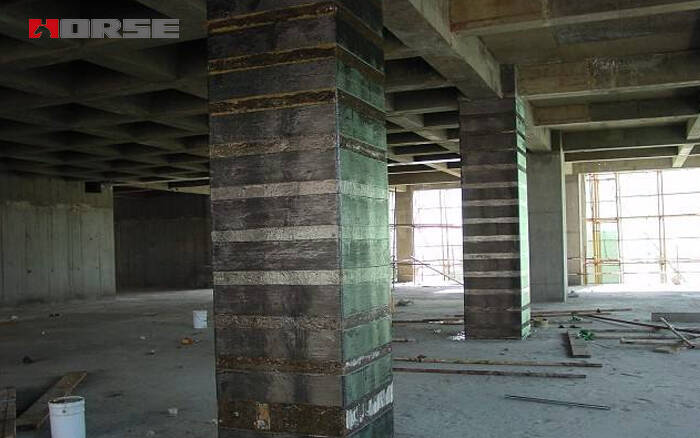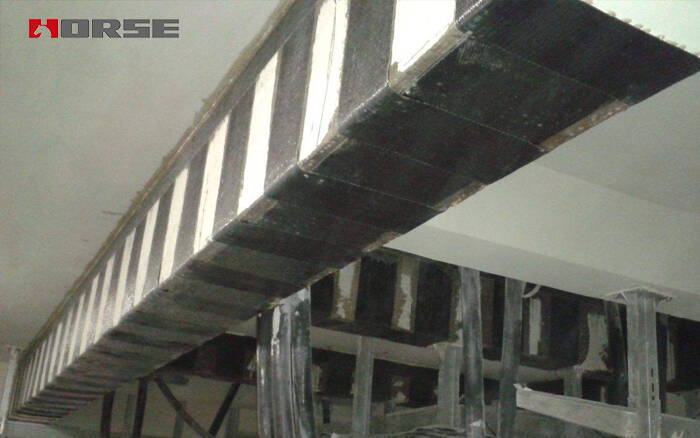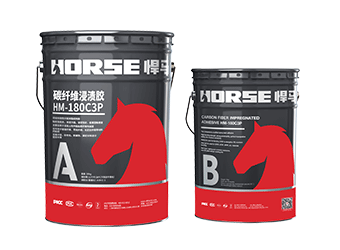Solutions
Horse Construction offers full range of structural strengthening materials with technical supports, documentation supports, products supports, project supports.
construction and application of unidirectional carbon fiber sheet to reinforce concrete structure

Carbon Fiber Reinforced Ploymer (CFRP) is a new high-strength material. In recent years, research and application in the field of construction engineering have developed rapidly. Compared with traditional structural reinforcement methods, carbon fiber reinforcement technology is a new and efficient reinforcement and repair technology, which has the advantages of high strength, high efficiency, convenient construction, and wide use. Among them, carbon fiber sheet is a new reinforcement and repair technology for concrete structures, and its construction method mainly adopts the "three-step method". That is, the two-component resin bonding material of the bottom layer resin, leveling material and resin impregnated resin is used to stick the carbon fiber sheet on the outer surface of the structural member to achieve the purpose of reinforcement. At present, in addition to the application in concrete, it is gradually being promoted to the reinforcement and repair of masonry structures, steel structures and even wood structures.
Reinforcement characteristics of unidirectional carbon fiber sheet
Among the reinforcement technology of concrete structure engineering, unidirectional carbon fiber sheet reinforcement has unique advantages compared with electrochemical reinforcement technology and bonded steel reinforcement technology.
1) Compared with electrochemical reinforcement technology
In the reinforcement of concrete structures, carbon fiber sheets can be laid and pasted on the required parts of the structure without changing the shape of the structure or affecting the appearance of the structure. Especially for offshore reinforced concrete structures, the bottom and sides of beams, slabs, ribs, and columns in the surge area. The cathodic protection system is difficult for the construction design of the component bottom, side and special structure, and sometimes it is difficult to realize.
In the electrochemical reinforcement method, the cathodic protection system should increase the weight of the original structure. The carbon fiber sheet reinforcement basically does not increase the permanent load of the structure or increases very little. After the carbon fiber sheet is pasted, the weight per square meter is less than 1.0 kg, and the thickness of the pasted layer is only 1 mm. After reinforcement and repair, the weight and size of the existing structure are basically not increased.
The electrochemical reinforcement method cannot reliably evaluate the reinforcement effect. Carbon fiber sheet reinforcement can be calculated according to the calculation method of the concrete structure, so that the reinforcement effect can be guaranteed, and it is possible to calculate the service life and reliability of the structure after reinforcement.
2) Compared with bonded steel reinforcement technology
The operation of sticking steel reinforcement technology is complicated. Carbon fiber sheet reinforcement construction is convenient, efficient, and has good operability. No bolts or rivets are required for the reinforcement construction, which has little disturbance to the existing structure, will not affect the integrity of the existing structure, and the construction quality is easy to guarantee.
Bonded steel reinforcement technology cannot be used in salty soil environments, marine environments, and chemically corroded environments. Therefore, it is restricted in the reinforcement of corrosion projects in underground structures, water supply and drainage structures, hydraulic structures, port structures, chemical workshops, etc. The investigation shows that these types of structures are the most severely damaged structures due to rust expansion. The reinforcement technology of carbon fiber sheet can adapt to the reinforcement of these types of structures.

Project
In the first phase of the renovation project of a department store in this area, after site survey and design calculations, it was found that the flexural bearing capacity of the local beams could not meet the requirements due to changes in the use functions of the first, second and fifth floors of the structure. After comparing the schemes, the unidirectional carbon fiber sheet is pasted in the length direction of the beam bottom, and the carbon fiber sheet is attached to the beam end to make a u-shaped hoop. It not only has a good anchoring effect on the carbon fiber sheet at the bottom of the beam, but also improves the shear bearing capacity of the end of the beam. The reinforcement design basis is as follows:
Paste carbon fiber sheets along the main axis of the component to improve the bending resistance of the front section of the component;
Paste the carbon fiber in the direction perpendicular to the main axis of the component, and the carbon fiber and the original stirrup share the shear force to improve the shear bearing capacity of the component;
Paste carbon fiber in the direction perpendicular to the main axis of the component to improve the ductility of the reinforced part and improve its seismic performance.
At present, the most widely used method in domestic engineering is the first method, that is, strengthening and repairing to improve the load-bearing capacity of the front section of the beam and slab so that it can meet the functional requirements of use.
Selection of carbon fiber composite materials
There are two main types of carbon fiber materials used for reinforcement and repair of concrete structures: carbon fiber and supporting resin binders. Carbon fiber is a high-strength and high-modulus material, and its strength is ten times that of steel. There are many types of construction adhesives, and it is the key to choose a good compatibility with a certain carbon fiber sheet. The bonding strength of the resin binder should be greater than the tensile shear strength of the concrete, and it has a suitable working viscosity to facilitate construction operations. The resin binder that matches the carbon fiber generally consists of four parts. That is, the primer adhesive, leveling material, impregnating resin and protective material.
The primer adhesive must be able to penetrate into the concrete surface to promote bonding and form the basis of a long-lasting interface;
Leveling materials are used to repair the flatness of the surface of the structure in order to use sheets;
The impregnating resin is used to impregnate the carbon fiber sheet to form an in-situ laminate on the concrete surface;
The protective material is used to protect the carbon fiber sheet from external conditions and extend its service life.
In conclusion
Because the construction period of the unidirectional carbon fiber sheet reinforced concrete structure is very short and the efficiency is high, the materials are processed manually on site. There is no loss of large and medium-sized equipment. The detection is convenient and fast, and the construction can be carried out in a small space at the same time. It basically does not affect the normal use of the structure. The construction is convenient. The shape of various structural members can be reinforced by this method. At the same time, due to the relatively light weight of the material, the structure will not increase the weight after reinforcement, and the appearance size and shape of the structure will not be changed. Compared with other reinforcement methods, it saves a lot of mechanical labor costs, labor costs and inspection costs.
The use of one-way carbon fiber reinforcement technology has little impact on the environment during construction, which meets the requirements of modern engineering construction and is conducive to environmental protection. In the long run, this technology will occupy a dominant position in the field of structural reinforcement.
You can find anything here you are in need of, have a trust trying on these products, you will find the big difference after that.

Good impregnation carbon fiber adhesive for applying carbon fiber reinforced polymer(CFRP) wrap for structural strengthening

High strength, unidirectional carbon fiber fabric pre-saturated to form a carbon fiber reinforced polymer (CFRP) fabric used to strengthen structural concrete elements.

High strength, unidirectional carbon fiber sheet pre-saturated to form a carbon fiber reinforced polymer (CFRP) sheet used to strengthen structural concrete elements.